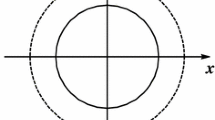Abstract
Hestenes spacetime algebra is used as a formalism for Light Polarization. A plane-like wave solution to the Maxwell equation in free space is studied. Its energy-momentum density is structurally related to the Poincaré sphere equation, Stoke’s parameters, and coherency matrices; while its energy momentum is that of light-like particles. The wave is leftcircularly polarized while its spatial inverse is right-circularly polarized. It is conjectured that other polarization states may be obtained by superposing left- and right-ircularly polarized states through Fourier Analysis.
Access this chapter
Tax calculation will be finalised at checkout
Purchases are for personal use only
Preview
Unable to display preview. Download preview PDF.
Similar content being viewed by others
References
S.A. Akhmahov and S. Yu Nikitin, Physical Optics, Clarendon, Oxford, 1997.
W.E. Baylis, J. Bonenfant, J. Derbyshire and J. Huschilt, Light polarization: A geometric algebra approach, American Journal of Physics 61 (1975), 556–572.
W.E. Baylis, J. Huschilt and Jiansui Wei, Why i?, Americal Journal of Physics 60 (1992), 788–797.
M. Born and E. Wolf, Optics: Electromagnetic Theory of Propagation, Interference and Diffraction of Light, Pergamon, Oxford, 1964.
B.K. Datta and V. de Sabbata, Hestenes’ Geometric Algebra in Real Spinor Fields. In: Spin in Gravity: Is it Possible to Give an Experimental Basis to Torsion?, 33–50.
Geometric Algebra Formulation of Maxwell’s Equations, http://www.arcturu2.demon.co.uk.
R. Gurtler and D. Hestenes, Consistency in the formulation of Dirac, Pauli, and Schrödinger theories, Journal of Mathematical Physics 16, 556–572.
H.A. Haus and J.R. Melcher. Electrodynamic Fields and Energy, Prentice Hall, New Jersey, 1989.
E. Hecht and A. Zajac, Optics, Addison-Wesley, California, 1974.
D. Hestenes, Observable operators and complex numbers in the Dirac theory, Journal of Mathematical Physics 16, 556–572.
B. Jancewicz. Multivectors and Clifford Algebra in Electrodynamics, World Scientific, Singapore, 1988.
R.A. Tripler. Modern Physics, Worth, New York, 1978.
T. Vold, Introduction to geometric algebra and its application to electrodynamics, American Journal of Physics 61, 505–513.
Editor information
Editors and Affiliations
Rights and permissions
Copyright information
© 2002 Springer Science+Business Media New York
About this chapter
Cite this chapter
Sugon, Q.M., McNamara, D. (2002). A Hestenes Spacetime Algebra Approach to Light Polarization. In: Dorst, L., Doran, C., Lasenby, J. (eds) Applications of Geometric Algebra in Computer Science and Engineering. Birkhäuser, Boston, MA. https://doi.org/10.1007/978-1-4612-0089-5_26
Download citation
DOI: https://doi.org/10.1007/978-1-4612-0089-5_26
Publisher Name: Birkhäuser, Boston, MA
Print ISBN: 978-1-4612-6606-8
Online ISBN: 978-1-4612-0089-5
eBook Packages: Springer Book Archive



